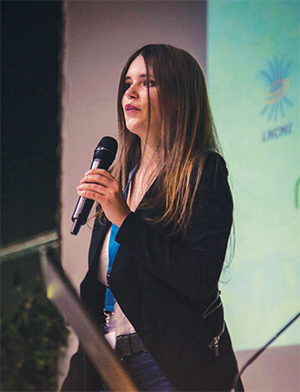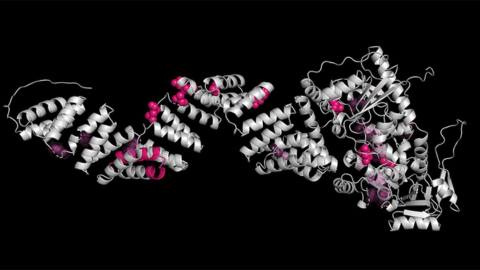An ASBMB course brought me closer to my SciComm career
My interest in science goes back to my early years in school, when biology was the most fascinating subject — at least to me. With a weird obsession, I could look through a microscope for hours to observe strange-looking insects or the fine structure of my own hair. So it came as no surprise that I decided a few years later to start on an academic career path by enrolling in a university to study biotechnology. This choice ultimately led me to my current position as a Ph.D. student.
My project involves studying how cells within the human body move. The topic is fascinating, considering that immune response, wound healing and diseases all are based on cellular movement. For decades, scientists all over the world have been trying to understand this fundamental process in order to develop novel therapeutic and diagnostic strategies to fight cancer and other diseases.
 Katharina Hennig welcomes two participants to the Rencontres des Jeunes Physiciens in Grenoble, France, and gives them instructions about their poster presentations. Hennig organized the 2017 conference for temporary university staff.
Katharina Hennig welcomes two participants to the Rencontres des Jeunes Physiciens in Grenoble, France, and gives them instructions about their poster presentations. Hennig organized the 2017 conference for temporary university staff.
This thought gave purpose to my research project and kept me motivated over the last four years. My experiences extend beyond anything I could have imagined before starting my Ph.D., but I always have felt something was missing, something besides doing experiments, analyzing data and presenting my work at conferences.
What was missing became obvious to me with time: As I got deeper and deeper into the world of science, it became increasingly difficult to explain the purpose of my work to my friends and family. But how could that be? How could I do such meaningful work but lack the ability to explain it to others? I eventually realized the importance of making science accessible to a broader audience. So I decided that I wanted to communicate science to everyone — not just to specialists in the field but also to nonexperts and (dare I even say) the world.
 Katharina Hennig greets participants, introduces sponsors and shares goals at the 2017 Rencontres des Jeunes Physiciens in Grenoble, France. PHOTOS COURTESY of ANDRES BERLESE About a year ago, I started looking for a career path outside my comfort zone of academia, and I found a field that immediately caught my interest: science communication, a profession for passionate scientists who want to share science with the general public in order to start a dialogue, raise awareness and engage people. After exhaustive online research, I became convinced that this might be the right track for me. With one more year as a Ph.D. student ahead, I decided to get involved.
Katharina Hennig greets participants, introduces sponsors and shares goals at the 2017 Rencontres des Jeunes Physiciens in Grenoble, France. PHOTOS COURTESY of ANDRES BERLESE About a year ago, I started looking for a career path outside my comfort zone of academia, and I found a field that immediately caught my interest: science communication, a profession for passionate scientists who want to share science with the general public in order to start a dialogue, raise awareness and engage people. After exhaustive online research, I became convinced that this might be the right track for me. With one more year as a Ph.D. student ahead, I decided to get involved.
I started off easy by signing in on Twitter. Twitter’s scientific community is huge. Researchers from all fields share their latest articles, promote their research and create an online network. This was not just helpful for me as a Ph.D. student; it also taught me what science communication (or SciComm, as the cool kids call it) was really about.
We scientists can share our passion in endless ways: explaining our research to friends and family in a casual environment, presenting our work in front of a nonscientific audience, blogging our stories online, or posting videos on YouTube. As I feel uncomfortable in front of a camera or crowd, my first choice of medium was the written word. Countless science magazines and blogs publish articles by science communicators, if their stories are newsworthy, well written and fit a journal-specific genre.
After a few attempts to pitch my stories to editors (not always successful), I realized that there is more to science communication than just randomly writing down my experiences. I needed help developing a successful and interesting online identity as a writer, and I found the guidance I was looking for in the American Society for Biochemistry and Molecular Biology online course “The Art of Science Communication.”
The eight-week course is taught by professional science communicators and outreach experts and involves about three to five hours of work per week. The training consists of three parts: watching explanatory videos online, participating in interactive discussion sessions on Skype and working on a final presentation at home. We started with a general overview of science communication, which led to more specific instructions on how to structure a talk effectively, what content to cover and how to improve communication skills.
Throughout the course, I became more aware of how to communicate science successfully. Gaining credibility and knowing the target audience are especially crucial to becoming a successful communicator. Step-by-step, week-by-week, we participants were guided through creating our own short presentation aimed at engaging a broad audience. The main obstacles in doing so were our scientific selves. We were used to using technical terms to describe every little detail. But once we understood that scientific jargon is the enemy of SciComm, our presentations transformed into exciting and educating talks suitable for both researchers and nonexperts.
As the grand finale of the course, we created videos of our thoroughly prepared presentations. After practicing my talk, it was time to record myself in front of a camera. I felt awkward at first, but it was great training. PowerPoint slides were not allowed, so I used gestures and random household items to visualize the biological processes I was explaining. For example, from a physical point of view, cells can behave as an elastic object. So I used a rubber band to demonstrate that cells usually elongate before suddenly initiating movement. Other participants drew simple sketches, used props or came up with other creative ideas to spice up their final talks.
In the end, I most probably will keep that short video to myself. But the lessons I have learned will help me to share my passion for science. I now feel a lot more confident explaining my Ph.D. project to my friends and family. In addition, I received valuable tips and tricks that helped me grow in my role as a science communicator — a career path that I, now more than ever before, consider to be the right choice for me.
The ASBMB training gave me strength and confidence (as well as a certificate) to apply for jobs outside my academic comfort zone, which ultimately brought me one step closer to my dream: making a living out of my passion for communicating science to the world.
Enjoy reading ASBMB Today?
Become a member to receive the print edition four times a year and the digital edition monthly.
Learn moreFeatured jobs
from the ASBMB career center
Get the latest from ASBMB Today
Enter your email address, and we’ll send you a weekly email with recent articles, interviews and more.
Latest in Careers
Careers highlights or most popular articles

Upcoming opportunities
Friendly reminder: May 12 is the early registration and oral abstract deadline for ASBMB's meeting on O-GlcNAcylation in health and disease.

Sketching, scribbling and scicomm
Graduate student Ari Paiz describes how her love of science and art blend to make her an effective science communicator.

Embrace your neurodivergence and flourish in college
This guide offers practical advice on setting yourself up for success — learn how to leverage campus resources, work with professors and embrace your strengths.

Upcoming opportunities
Apply for the ASBMB Interactive Mentoring Activities for Grantsmanship Enhancement grant writing workshop by April 15.

Quieting the static: Building inclusive STEM classrooms
Christin Monroe, an assistant professor of chemistry at Landmark College, offers practical tips to help educators make their classrooms more accessible to neurodivergent scientists.

Unraveling oncogenesis: What makes cancer tick?
Learn about the ASBMB 2025 symposium on oncogenic hubs: chromatin regulatory and transcriptional complexes in cancer.

